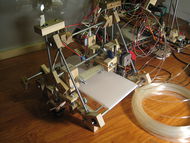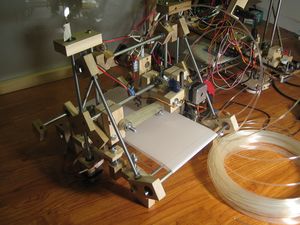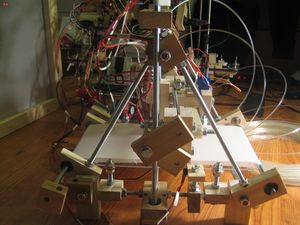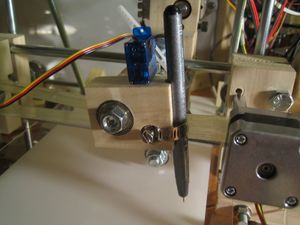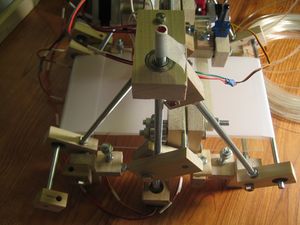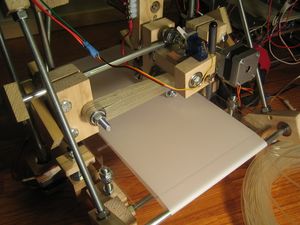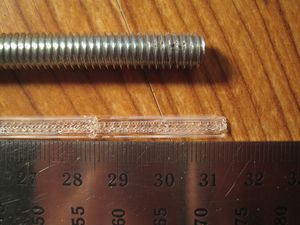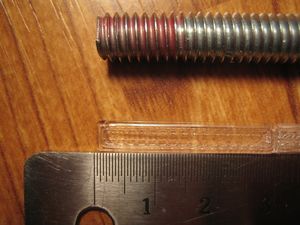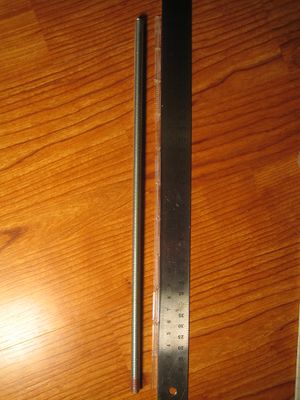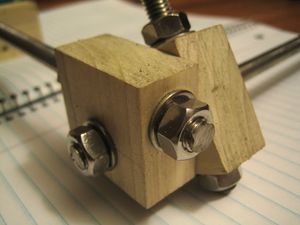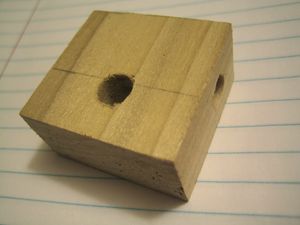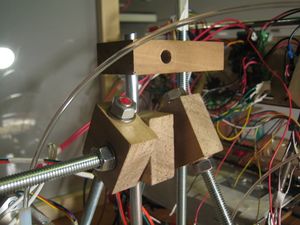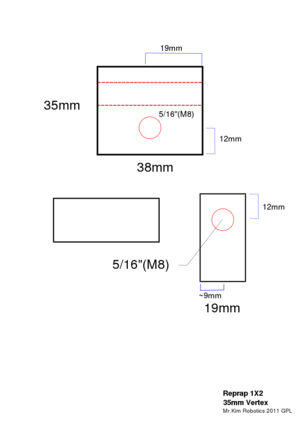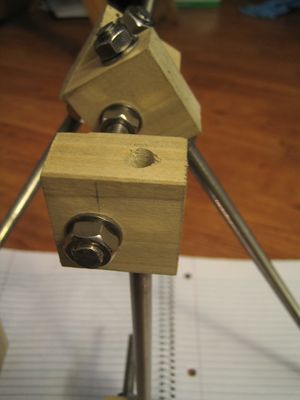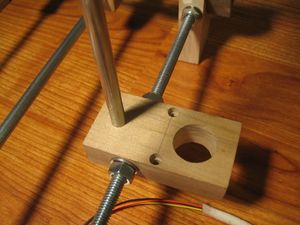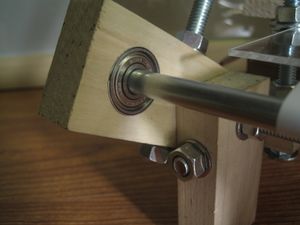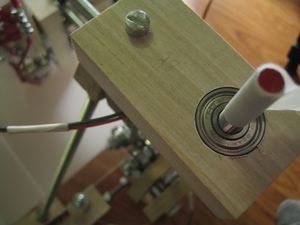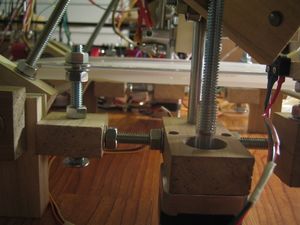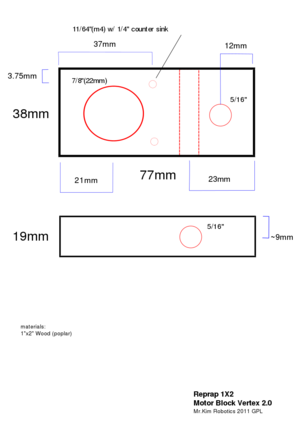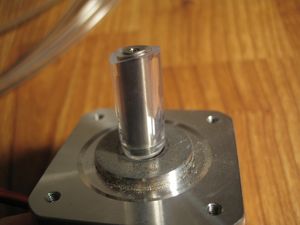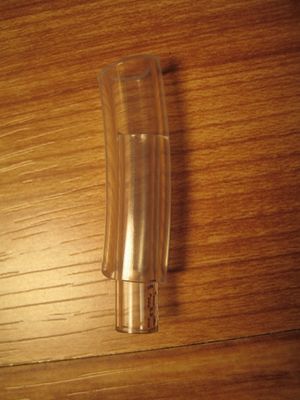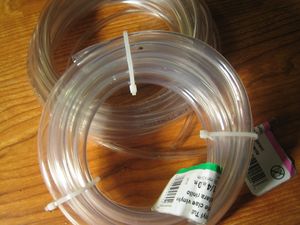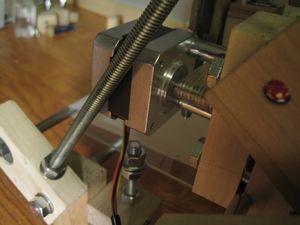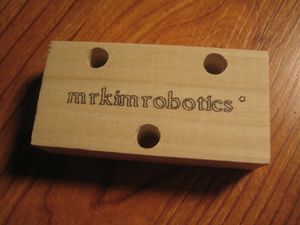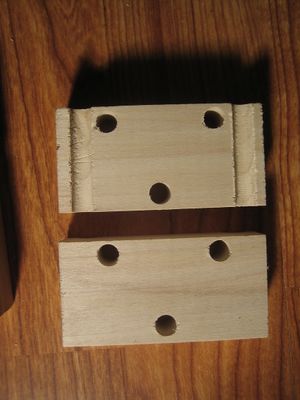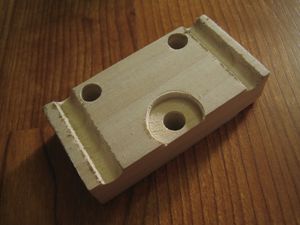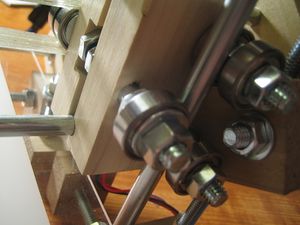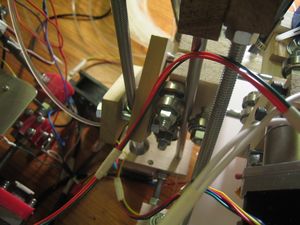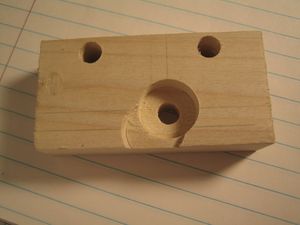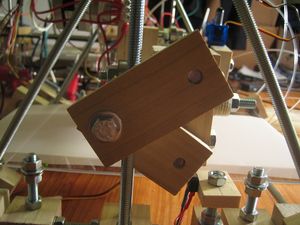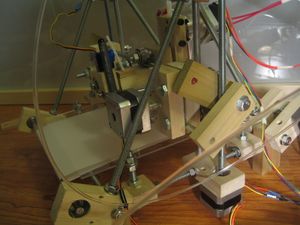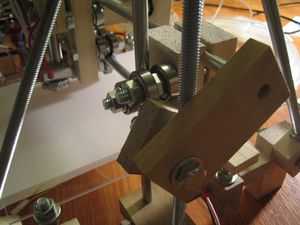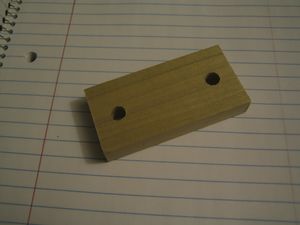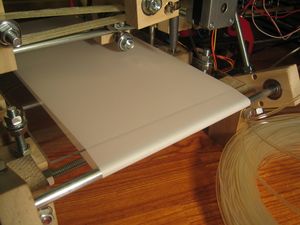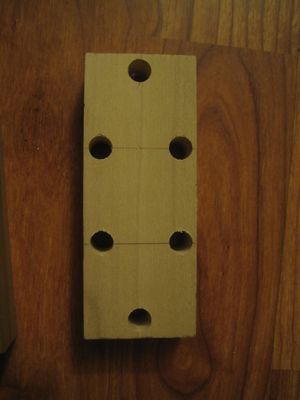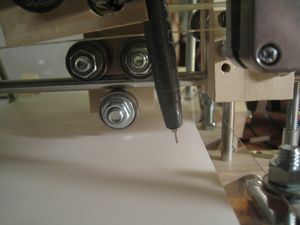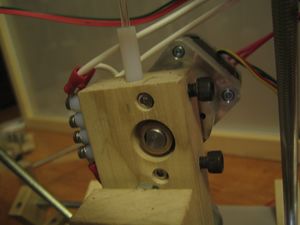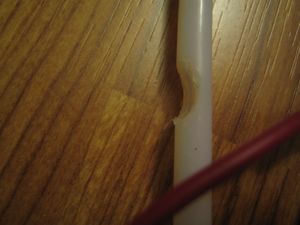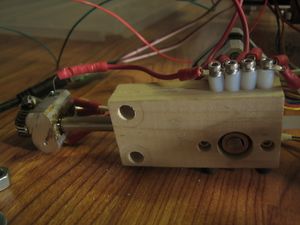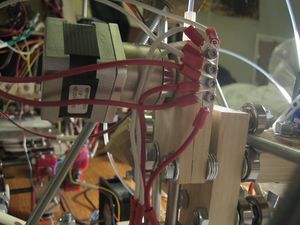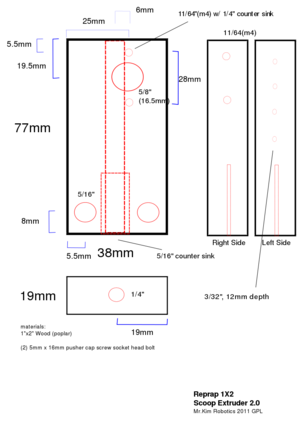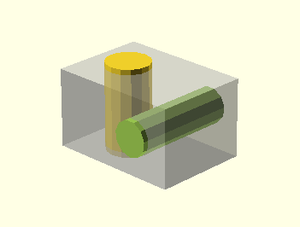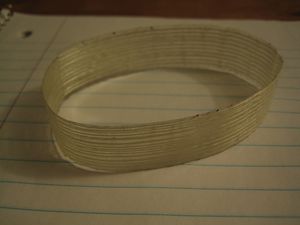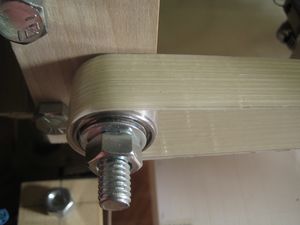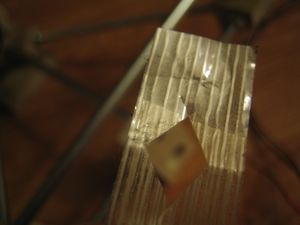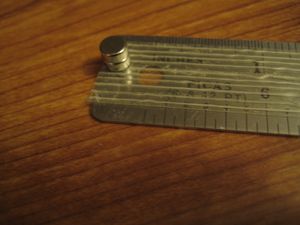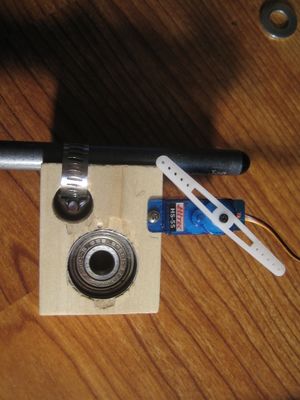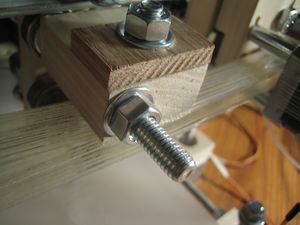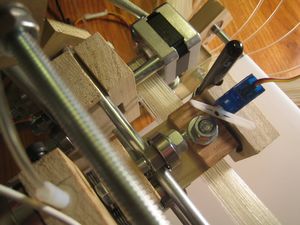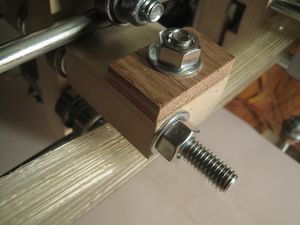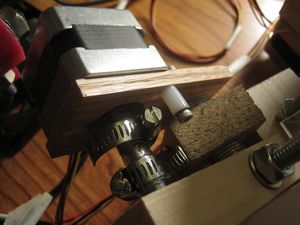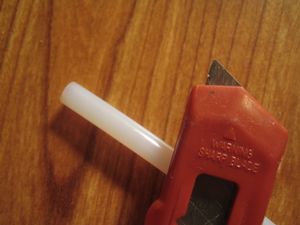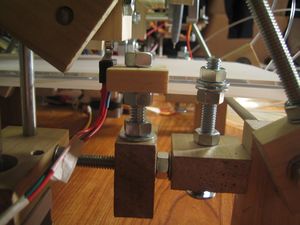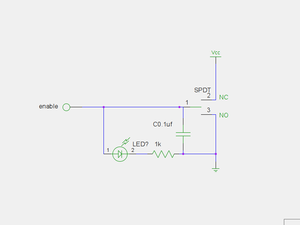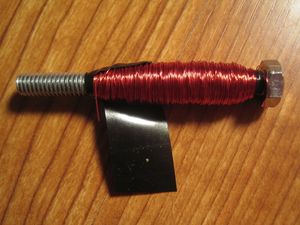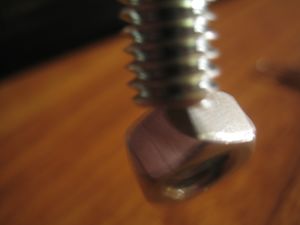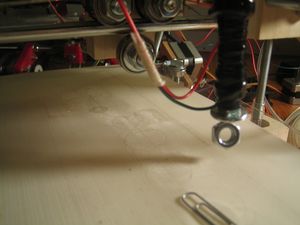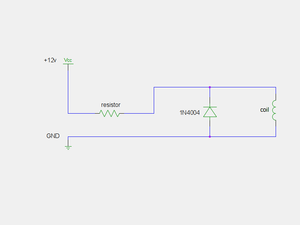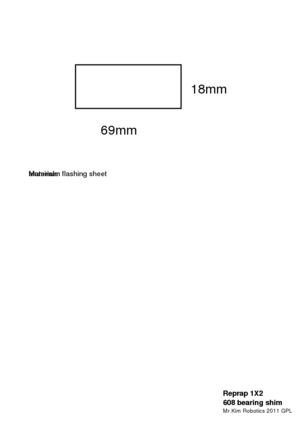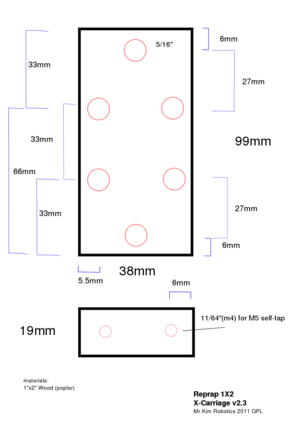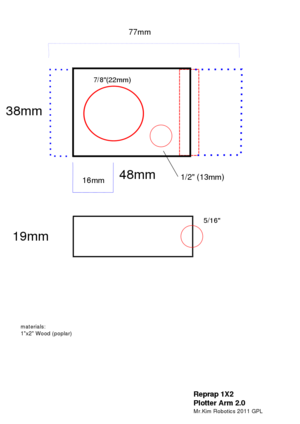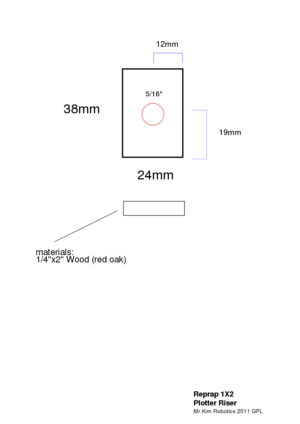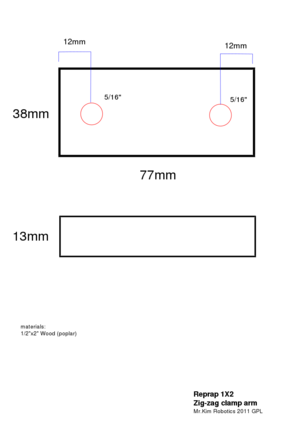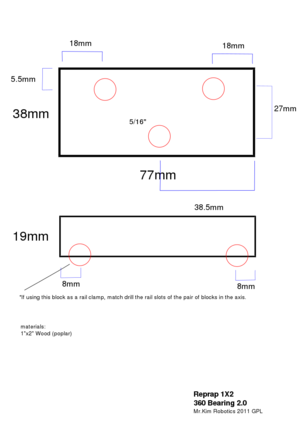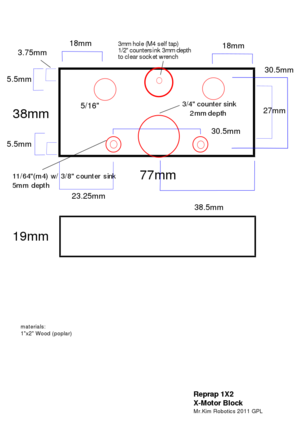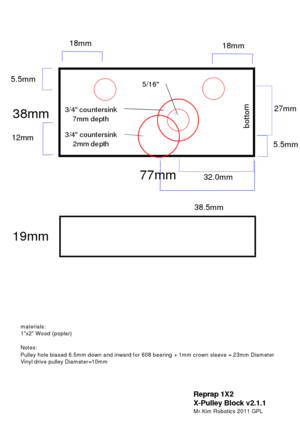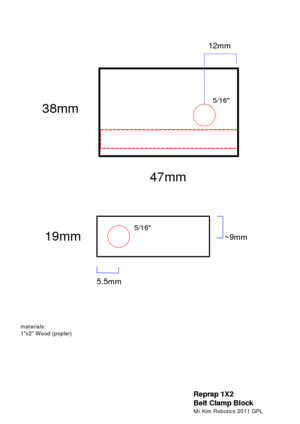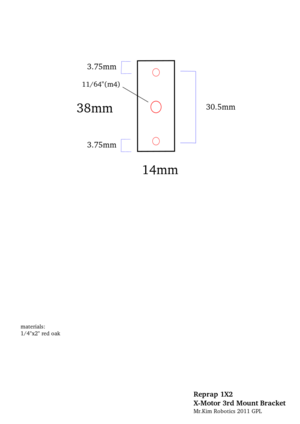1X2
Release status: Experimental
| Description | Perky Wooden RepStrap
|
| License | |
| Author | |
| Contributors | |
| Based-on | |
| Categories | |
| CAD Models | |
| External Link |
Contents
- 1 Description:
- 2 Status Summary:
- 3 Features:
- 4 Continuous Raftless Multilayer Object Larger than Longest Bar of a Reprap:
- 5 Continuous Raft:
- 6 1X2 Vertex:
- 7 Motor Block:
- 8 Vinyl Drive Pulley:
- 9 360 Bearing v2.0:
- 10 Pulley Block:
- 11 Zig-Zag clamp:
- 12 1X2 Conveyor Belt:
- 13 X-carriage:
- 14 Scoop Extruder v2.0:
- 15 Heater Block:
- 16 DIY Tape Belt:
- 17 1X2 Plotter Head:
- 18 Belt Clamp Block:
- 19 Thin-profile motor mount:
- 20 DIY M3 Teflon Stadoff Spacers:
- 21 End stop:
- 22 Magnetic Pick and Place Head:
- 23 Plans:
- 24 Assembly:
- 25 Notes:
- 26 Misc:
Description:
The 1X2, 1X2 Shortcat, and 1X2 Tallcat are Reprap class 3D-printers that can be built with access to only a drill-press and hand-saw. The parts for the entire system can be made with one-dimensional tools, straight cuts and common materials.
This machine is made by: mrkimrobotics.com
Status Summary:
Working Status:
The 608 linear bearing system works well and is mature.
The shaft-couplers for leadscrews and axles work well.
The 1X2 vertex frame system has worked well.
The Scoop Extruder has printed continuously for many hours with no issue.
The flat belts themselves are strong, efficient and easy to construct.
Experimental Status:
Consistently countering "belt creep" with non-slipping elastic flat-belts in open-loop control as a function of speed remains an issue of study.
- The 'Droftarts method' homes X and Y between each layer to correct for creep/crawl drift.
- If someone wants to try a linear magnetic sensor on the conveyor-belt for absolute positioning, post your results here.
Features:
- It has a printable area greater than all of its parts(including the rods).
- Dual-head extruder and plotter(w/ hot and cold separation).
- Simultaneous extrusion and plotting.
- Quick-change plotter head.
- Narrow x-carriage design.
- It uses only 608 bearings.
- It uses only 5/16" bolts.
- It uses all 1-unit length rods.
- It uses all DIY belts.
- Uses all DIY drive pulleys.
- Uses all DIY couplers.
- Full conveyor-belt y-axis.
- One piece x-carriage design
- One piece extruder design
- One piece plotter design
- Adjustable conveyor belt tension with bed height.
- Conveyor-belt goes to both edges of the machine for end-to-end chaining of machines.
- Hand-crank for conveyor belt.
- A single block is capable of building all frame vertex points.
- A single extended block is used for Nema17 motor mounts, 608 bearing axle supports and pillow-blocks.
- The 5/16" holes fit both 8mm & 5/16" hardware.
- Works with variable lengths. The design is not length specific, so you can build a range of machine sizes, from full size to compact with the same pieces.
- The frame is chainable, you can build a linked multiple segment Longcat machine.
- It uses only 1"x2" wood for all parts.
- It uses a 35/77 system, where most of the parts are either 35mm or 77mm in length. The parts for the entire system can be cut to length in two fixture setup runs(with a few exceptions).
- All cuts are 1-dimensional 90 degrees.
Scoop Extruder:
- Adjustable tension with no pulleys or pusher blocks.
- The "scoop" extruder uses the PTFE tube itself as the "idle pulley"
- It uses the Makerbot Mk5 nozzle and hot-end tube.
- Makergear style geared stepper.
- Raysyu drive gear.
- A Nophead style heater block.
Plotter Head:
This single pivot floating head plotter arm works consistently over a wide range of surfaces. The servo actuation provides fast on-off movements. The entire plotter arm and servo can be removed or switched with another pen without taking the pen out of position. The large 5/16" holding nut uses low force and acts as a knob that can be easily spun on/off by hand. The band clamp pen holder can hold just about any pen sized tool.
Continuous Raftless Multilayer Object Larger than Longest Bar of a Reprap:
This was originally posted Feb. 20, 2011. This is a multilayer beam 313mm long, printed on a Reprap 1X2 whose largest component is a threaded rod 306mm long.
This was printed with the 1X2 stepper driven conveyor-belt y-axis in a repeating pattern of 30mm bricks.
<videoflash type="youtube">pRLKnfQoPAU|320|240</videoflash>
Continuous Raft:
<videoflash type="youtube">WSsPWOoyY2g|320|240</videoflash>
1X2 Vertex:
This part has generic support for modular triangulated structures. It solves the problem of building angular structures without having to drill accurate angled holes. It uses 5/16" rods of variable lengths.
This split vertex is easy to construct with only two straight holes and one straight cut in 1" x 2" wood. This single piece is repeated to form all the vertex points and fixed rail mounts in a frame structure. Since the part can be cut in a single jig setup, the entire frame set can be cut in a few minutes.
Motor Block:
This is the 77mm 1X2 vertex block that mounts Nema17 motors and 608 bearing pillow blocks. This block makes the motor block, pillow block, and shaft supports for the Reprap 1X2
This Motor Block uses no bolts to retain the 608 bearing and all the holes are shallow depths.
An aluminum shim is used when mounting the 608 bearing. This is a low force press-fit that is reversible. Aluminum Flashing with tin snips or Soda Cans which can be cut with sissors.
Cut shim to length 69mm (22mm * pi) x 19mm.
Vinyl Drive Pulley:
It is made of two pieces of vinyl tubing.
Materials:
1/4" OD x 0.170" vinyl tubing
3/8" OD x 1/4" ID vinyl tubing
Assembly: Cut a section of each of the tubing sizes to a length slightly less than the motor shaft. For Example: The Kysan 1123029 motor with a shaft length of 24mm, cut 22mm sections of tubing.
First slip the smaller 1/4" tubing into the larger 3/8" tubing. Then press the compound tube onto the motor shaft. Done!
This part is also the Nema17-5/16" shaft-coupler.
Vinyl Pulley and flat tape belt in action:
<videoflash type="youtube">XRgg57JnIOI|320|240</videoflash>
360 Bearing v2.0:
This is the linear bearing system used in the Reprap 1X2 z-axis.
This is a 360 degree constraining bearing assembly has adjustable tension. To fabricate, it only requires (3) holes in the same plane for both upper and lower bearing constraint. It also has a small amount of overhang.
How it works:
As the "draw-down" bearing is tightened, it presses against a wider chord section of the round rail. This wedge effect tightens the rail against the opposing "capture bearings".
Because v2.0 uses larger 608 bearings and 5/16" bolts, a single draw-down bearing can be used for two sets of capture bearings, reducing the bearing count by one.
Design:
608 "skate" bearings are ubiquitous and can be found in local stores.
There is also a printable 608 bearing that is theoretically interesting.
Ball-bearing "jet-rails" are less sensitive to shaft tolerance than bushings, have low stiction, and lend themselves well to using plain round shafts.
The 624 bearing based v1.0 system worked better than expected and it allowed us to build all the axes of the robot easily with a drill-press. This design is more robust and has a lower bearing count than v1.0. In this arrangement (5) 608 bearings completely constrain an axis side. Two of these assemblies fully constrain a two rail axis with (10) bearings.
Version 1.0 used (6) bearings on a 360 side and (4) bearings on a 180 side for a total of (10) bearings as well, but with less side load constraint.
The 360-180 Sells arrangement solved over-constrained jamming issues with Darwin, but was susceptible to bent leadscrew wobble.
The present system has 360-360 side-load constraint at the same bearing count.
The grooves hold the x-rails are match drilled so they are parallel.
On the original 1X2 Compact which is relatively short, the motor and pulley were mounted on the back-side of the x-rail clamp. The bolt hole for the x-idle pulley has a countersink so the x-rail clamp can have bolts point outward in both directions. Subsequent designs use a taller frame that can mount the pulley above the x-rail clamp and therefore removes the requirement for a countersink and makes access to the bolt much easier.
Assembly:
For a custom standalone carriage:
(3) 2" 5/16" bolt
For use with 1"x2" clamp blocks(original Reprap 1X2):
(1) 2" 5/16" bolt
(2) 3" 5/16" bolt
For use with thin-profile clamp blocks(original TALLCAT style):
(1) 2" 5/16" bolt
(2) 2-1/2" 5/16" bolt
For use with thin-profile 360 block and thin-profile clamp blocks(SHORTCAT style):
(3) 2" 5/16" bolt
Assembly pattern:
All three bolts face outward.
Capture bearings:
(washer, 608, nut(hand tight), 608, nut)
Draw-down bearing:
(back-stop nut, 608, washer, nut)
Pulley Block:
This holds the x-idle pulley and clamps one side of the x-rails.
Zig-Zag clamp:
This is the leadscrew-nut constraint for the Reprap 1X2.
By triangulating two equal length control arms from each rail with a pinch bolt, the clamp doubles as a perpendicular constraint to drive the rails rigidly in the direction of the leadscrew-nut.
Design:
Drill-press Reprap v1.0 used a pressed-in leadscrew nut, where the leadscrew was normal to the face of the axis. Though this was robust and easy to make, the Zig-zag clamp is easier still, it has no pocket holes and no one way press-fittings. The Zig-zag clamp is adjustable to different nut sizes within the travel available by the mounting rails.
This clamps a leadscrew-nut on a linear axis parallel to the face of the axis.
This clamp also works with counter offset rails by spanning the offset stagger on the ends of the rails. The offset rails allow the total width between the leadscrew-nuts to be greater than the length of a single rail, where all rails are 1-unit length.
As the rail offset is increased the parallel section is decreased. The parallel section must be wide enough for the axis travel and the z-axis bearing block that constrains the distance between the rails.
Hardware:
(2) 2"-5/16" bolt (pinch bolt)
(2) 5/16" nut
(4) 5/16 washer
1X2 Conveyor Belt:
This is the conveyor belt used for the y-axis.
Materials:
Polyester Drafting Film
(Grafix ".003")
Wide fiberglass reinforced tape.
(3M Filament Tape 898 Clear, 39mm wide)
Results:
The fiber reinforced belt significantly resists heat warp.
The original version used plain Drafting film. The drafting film is moderately inelastic, flexible and grips the plain metal shaft. The second version tried reinforcing the belt with fiberglass tape to make it behave more like an inelastic steel reinforced belt. The tape did not grip the plain metal shaft, so a self-vulcanizing automotive rubber tape was used on the drive shaft. This gave very good grip. The reinforced belt is stiffer so it is less efficient, and requires more force to drive it, which negates part of the increase in inelasticity. The belt crawl/creep was still present in the reinforced belt.
Assembly:
The inside surface is laminated with fiberglass reinforced tape. The fibers run the length of the belt.
Join: The current preffered method to join the belt is to use short tiled strips with the fibers running length-wise. This makes the strongest and most flexible seam.
X-carriage:
It uses (7) 608 bearings. A 360 degree constraint on the bottom and a 180 degree constraint on the top.
Scoop Extruder v2.0:
The Scoop Extruder has adjustable tension and uses no pulleys or pusher blocks. It is a single block made with straight cuts.
The "scoop" extruder uses the PTFE tube itself as the "idle pulley".
There is a scoop shaped cutout in the tube that allows the drive gear to move the filament.
It uses the Makerbot Mk5 nozzle and hot-end tube.
Makergear style geared stepper.
Raysyu drive gear.
A Nophead style heater block.
The two motor mount holes are slightly over-sized from M3 to M4 to allow for the travel.
Heater Block:
The Heaterblock pictured used a bicycle crank as source material.
If you don't have scrap bicycle cranks, small squares of aluminum can be sourced on-line.
It was cut with a hand hacksaw, and drilled in a drill press.
Aluminum foil was used to shim the heating resistor.
DIY Tape Belt:
This drive belt is made of fiber reinforced packaging tape. Both open and closed loop belts are easy to make.
v.2.0 Uses two layers of tape.
v.2.1 Uses a third layer of drafting film in between.
The 1X2 Compact used a diamond hole to secure the belt.
The subsequent top clamp design required no holes in the belt.
Materials:
3/4" fiber reinforced plastic packaging tape.
(3M Filament Tape 898 Clear, 3/4 in x 60 yd)
v.2.1 Grafix ".003" polyester drafting film
For the 1X2 X-belt: (2) 490mm sections of tape (holes ~460mm on center) For motor-block v2.1.3 Shorten the holes by 2mm. (holes ~458mm on center)
Are you ready for this: Stick two layers of tape together facing each other to make the belt.
Here is the real secret: We use magnets on the ends of a metal ruler to hold down long sections of tape. Place the sticky side up along the edge of the ruler. Then stick the second piece of tape down all at once. It gives better alignment this way.
For each open end of the belt, apply a 1-inch layer cross-wise over the end.
Now fold the end of the belt where you want the mount point to be, and cut a small diamond hole with a pair of scissors. Done!
- The hole in the picture is a little bigger than it needs to be. But the tape is very forgiving, you can just put another piece of tape over it.
v2.1
Apply the tape to one edge of the polyester film.
Flip over.
Apply the tape to the other side of the polyester film.
Cut along the inside edge of the tape to free the belt from the rest of the film stock.
Cut the diamond holes as before.
Done!
1X2 Plotter Head:
Design:
This single-pivot floating head plotter arm works consistently over a wide range of surfaces. The servo actuation provides fast on-off movements. The entire plotter arm and servo can be removed or switched with another arm module without loosening the pen from its position. The plotter head is light weight and compact. It can be easily disconnected to get the absolute maximum travel or minimum flying weight. The large 5/16" holding nut uses low force and acts as a knob that can be easily spun on/off by hand. The band clamp pen holder can hold just about any pen sized tool.
It uses a standard Micro size servo. (We have had good luck with Mpi and Hitec)
- Possbile future use of a printed solenoid
Hardware:
(2) 608 bearings
(1) #4 band clamp
(1) 5/16" nut
(1) Microservo
(1) Plotter riser plate (1) Aluminum bearing shim
The pair of 608 bearings use the same aluminum shim as the 1X2 motor block.
Belt Clamp Block:
This sits between the X-carriage and the plotter mount.
Thin-profile motor mount:
The thin-profile y-motor-block uses (2) 11mm DIY M3 teflon standoffs
DIY M3 Teflon Stadoff Spacers:
Never run out of M3 spacers in the middle of the night.
Always have the spacer that is the exact right length. Why didn't I think of this before?
Materials: PTFE tube 1/4" OD, 1/8" ID (mcmaster 5033K31)
Cut to length with Utility knife. Done!
End stop:
It has adjustable height and a pivoting split clamp.
The simple circuit is normally 'on' to indicate a failure in the limit switch.
Design:
A table mounted z-limit switch would be optimal, but this one is just easy to construct and adjust.
The split clamp is made from a standard 35mm 1X2 vertex block.
3" carriage bolt pressed with bolt pressure.
1/4" x 2" (25mmx38mm) switch mount block.
Magnetic Pick and Place Head:
A 200ft roll of 30-gauge magnet-wire will be 20ohms.
The essential difference between this and a heating-coil is that this one has higher resistance, which results in running less current.
Where Current = I
Ohm tells us that: I = V/R
Using the Reprap extruder heating element as a reference:
12v/6ohm = 2 Amps
Power = V * I
12v * 2A = 24Watts
With a 5v source we don't need any resistors to keep the current resonable:
12v/20ohm=0.25A
5v*0.25A = 1.25w
With a 12v source we need more wire or if that is not an option some resistors.
Make sure not to exceed the power rating on the resistors themselves. Typical resistors are rated for 1/2watt of power. But you should only run them at half their rating.
Diode:
When the power is turned off the field in the coil will collapse and send current into the circuit. To keep this from potentially damaging the transistor, we put a diode across the coil so that the current in the open circuit just goes around the coil.
Core:
The magnet is more powerful with a metal core so we will use a bolt.
Details:
Where:
u = permeability of the core material
l = length of core
N = number of turns
A = cross sectional area
I = current in Amps
L=((N^2)uA))/l
Energy in joules = 1/2 LI^2
Materials:
5/16" bolt
Magnet wire
Electrical tape
(1) Diode 1N4004
- resistors
Assembly:
Wrap the bolt in a layer of electrical tape to keep the sharp threads from potentially cutting into the wire enamel.
Tape the end of the wire to the base of the bolt to secure it, leaving about 3" of lead.
Spin the bolt with your hand for about 5min to wrap the coil.
Secure the coil in place with a layer of electrical tape wrap.
Run the leads of the magnet wire through some fine-grit sandpaper to remove the coating.
Solder on the extension cable. Tape for strain-relief.
You now have DIY Coil.
Video of the coil in action (very first pick-and-place test with small coil):
<videoflash type="youtube">NI27JZ62C3k|320|240</videoflash>
Plans:
Assembly:
There is also some assembly instructions playlists in the 3D Printer section on the home site. [1]
